|
|
|
Sort Order |
|
|
|
Items / Page
|
|
|
|
|
|
|
| Srl | Item |
| 1 |
ID:
182037


|
|
|
|
|
| Summary/Abstract |
Resurgent expressions of an “action-reaction” arms race narrative and its corollary “inaction-inaction” narrative are the basis for frequent assertions that if the United States would only stop its nuclear programs, opponents would also stop building their nuclear force—and a “peace race” would ensue. In other words, U.S. efforts to maintain its deterrence capabilities are seen as sparking or accelerating the “arms race.” This argument has its roots in the 1960s; it has not changed since then. This same claim is now leveled at the contemporary and much-delayed U.S. nuclear modernization program. As in the past, the claim now commonly expressed is that current U.S. efforts to preserve its strategic deterrence forces are the cause of a new action-reaction arms race cycle and should, therefore, be stopped. However, history disproves the action-reaction/inaction-inaction narrative. An examination of numerous documents regarding the development of U.S. strategic policy—including now-declassified governmental and unclassified non-governmental studies and books that that have closely examined this issue—and interviews with a bipartisan group of former officials and knowledgeable academics demonstrates the flaws in this narrative and sets the record straight regarding U.S. policy developments and the factors that drove those developments.
|
|
|
|
|
|
|
|
|
|
|
|
|
|
|
|
| 2 |
ID:
106259
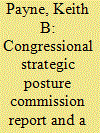

|
|
|
|
|
| Publication |
2011.
|
| Summary/Abstract |
The bipartisan Congressional Strategy Posture Commission offered numerous recommendations to reduce what it labeled "the nuclear danger." The Obama Administration has pursued some of these recommendations via its policy documents, such as the 2010 Nuclear Posture Review, its budgets, and plans. There is reason, however, for several concerns in this regard. These involve the high priority placed on nuclear force reductions at the potential expense of other national goals, including deterrence and assurance; the maintenance of the flexibility and resilience of the U.S. force posture necessary to meet deterrence and assurance requirements now and in the future; continued support for U.S. strategic defensive capabilities given Russian opposition; and apparent interest among some in the Administration to move increasingly toward what has been termed a policy of Minimum Deterrence.
|
|
|
|
|
|
|
|
|
|
|
|
|
|
|
|
| 3 |
ID:
083412
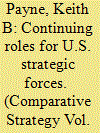

|
|
|
|
|
| Publication |
2007.
|
| Summary/Abstract |
The rise of hostile rogue states, new terrorist threats, and the proliferation of WMD and missile technology have all highlighted our need for an effective deterrence strategy in this post-Cold War environment. The fundamental questions of strategy we now face are to understand what and how we may be able to deter in a new strategic environment. Unfortunately, most of what we believed was true about deterrence during the Cold War is now misleading because international conditions have changed so dramatically. This conclusion does not suggest that we discard deterrence. It does, however, explain why our Cold War strategy of deterrence based on offensive nuclear forces and a mutual balance of terror must be reconsidered in toto
|
|
|
|
|
|
|
|
|
|
|
|
|
|
|
|
| 4 |
ID:
116346


|
|
|
|
|
| Publication |
2012.
|
| Summary/Abstract |
A commonly held view is that nonstate actors cannot be deterred. A historical review of deterrence vis-à-vis nonstate actors, however, shows that deterrence can be applied successfully to terrorist groups for some purposes and at some times. An examination of the sensitivities, vulnerabilities, and other characteristics of the core al-Qa'ida group suggests a combination of denial and punitive deterrent measures could be used to discourage this nonstate actor from attempting a mass-casualty attack.
|
|
|
|
|
|
|
|
|
|
|
|
|
|
|
|
| 5 |
ID:
097838


|
|
|
| 6 |
ID:
110873


|
|
|
|
|
| Publication |
2012.
|
| Summary/Abstract |
Analyses of U.S. strategic force requirements frequently are based on assertions about the requirements for deterrence. A politically attractive position is that a relatively small number of nuclear weapons reliably meets U.S. strategic nuclear requirements. This position, however, is flawed for two reasons: first, the number/types of nuclear weapons required for deterrence cannot be identified with precision because requirements shift dramatically across time and circumstances. Second, strategic forces also are intended to assure allies and limit damage, and these goals entail separate requirements that must be included in any serious calculation of U.S. strategic force requirements.
|
|
|
|
|
|
|
|
|
|
|
|
|
|
|
|
| 7 |
ID:
170444


|
|
|
|
|
| Summary/Abstract |
In 1973, at the age of 44 and the height of the Cold War, James Schlesinger was confirmed as the 12th U.S. Secretary of Defense. While serving as Defense Secretary, Dr. Schlesinger implemented important nuclear policy developments designed to strengthen the deterrence of war and the assurance of allies. His 1974 adjustments to U.S. nuclear policy, known as the Schlesinger Doctrine or the Schlesinger Shift. The Schlesinger Doctrine advanced the basic parameters of U.S. nuclear deterrence policy that contributed to the peaceful ending of the Cold War and have remained constant across Republican and Democratic administrations to the present. It is hard to conceive of a more significant defense-policy legacy.
|
|
|
|
|
|
|
|
|
|
|
|
|
|
|
|
| 8 |
ID:
028552
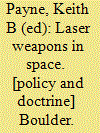

|
|
|
|
|
| Publication |
Boulder, Westview Press, 1983.
|
| Description |
xi, 230p.
|
| Standard Number |
0865319375
|
|
|
|
|
|
|
|
|
|
|
|
Copies: C:1/I:0,R:0,Q:0
Circulation
| Accession# | Call# | Current Location | Status | Policy | Location |
| 026174 | 358.8/PAY 026174 | Main | Withdrawn | General | |
|
|
|
|
| 9 |
ID:
028553
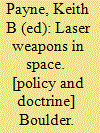

|
|
|
|
|
| Publication |
Boulder, Westview Press, 1983.
|
| Description |
xi, 230p.
|
| Standard Number |
0865319375
|
|
|
|
|
|
|
|
|
|
|
|
Copies: C:1/I:0,R:0,Q:0
Circulation
| Accession# | Call# | Current Location | Status | Policy | Location |
| 023108 | 358.8/PAY 023108 | Main | On Shelf | General | |
|
|
|
|
| 10 |
ID:
130017
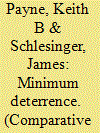

|
|
|
|
|
| Publication |
2014.
|
| Summary/Abstract |
Minimum Deterrence proposals claim that a relatively small number of nuclear weapons, measured in single digits to hundreds, is an adequate nuclear force for all pertinent U.S. deterrence missions, including extending U.S. nuclear deterrence coverage to U.S. allies. The vulnerability of an adversary's population and economy to nuclear weapons and the assumed high value of these targets to opposing leaders is the basis for the confident claims of Minimum Deterrence proponents that U.S. deterrence requirements can be met with a small number of nuclear weapons.
Contemporary proponents of Minimum Deterrence often argue that reducing to low nuclear force levels would:
1. provide deterrence that is more "stable" and greater safety than otherwise would be the case;
2. facilitate nuclear arms control agreements and successful non-proliferation policies;
3. provide substantial savings in the defense budget; and,
4. help create the conditions necessary for a more peaceful world order and help realize the goal of eliminating nuclear weapons entirely, i.e., "nuclear zero."
Recently, some U.S. officials and serving military officers have openly expressed support for the basic points and recommendations of Minimum Deterrence. Given the increased visibility of Minimum Deterrence and its potential to shape forthcoming U.S. policy decisions, it is important to identify the fundamental assumptions, logic and related conclusions of Minimum Deterrence proposals, and determine whether they are sound and consistent with available empirical evidence.
Minimum Deterrence claims generally are predicated on the following series of eight interrelated propositions:
v Deterrence will function reliably and predictably at low U.S. nuclear force numbers, now and in the future. U.S. conventional forces can substitute in many cases for nuclear forces to meet U.S. deterrence goals.
v Nuclear deterrence considerations no longer are pertinent to U.S. relations with Russia and China.
v Nuclear weapons are irrelevant to today's most pressing security threat-weapons of mass destruction (WMD) terrorism.
v Deterrence considerations alone determine the size and composition of the nuclear force requirements.
v Ballistic missile submarines (SSBNs) will remain invulnerable for 30 to 50 years. So, a small SSBN fleet can provide most or all of the nuclear capability needed for U.S. deterrence needs, now and in the future.
v The number of nuclear weapons and the risk of accidents and crises are directly correlated (more nuclear weapons means increased risk, while a decrease in their number reduces the risk).
v U.S. nuclear force reductions are essential to, and will strengthen, nonproliferation efforts; reductions also will facilitate further arms control progress. The Nuclear Non-Proliferation Treaty (NPT) requires U.S. movement toward nuclear disarmament.
v A small number of nuclear weapons is adequate for deterrence; thus U.S. defense spending can be reduced considerably by reducing nuclear forces.
Not all proposals for Minimum Deterrence include each of the eight elements. Several are of more recent vintage. But, a systematic examination reveals that these elements, implicitly or explicitly, are part of the contemporary Minimum Deterrence narrative.
The Obama administration's expressed policy positions undergirding its initiatives for nuclear reductions implicitly or explicitly reflect some, but not allof these eight Minimum Deterrence points. Particularly apparent in this regard is the presumed ability to predict with confidence and precision how deterrence and extended deterrence will work at much lower U.S. nuclear force levels.
Each of these eight points is described and critically examined here.
|
|
|
|
|
|
|
|
|
|
|
|
|
|
|
|
| 11 |
ID:
086612


|
|
|
|
|
| Publication |
2009.
|
| Summary/Abstract |
The key missile defense questions facing policymakers today are what kind of systems should be fielded and to what extent should investments be made in future missile defense technologies. In recent years, some have argued that more investments are needed to counter theater-range missile threats, even if such investments come at the expense of developing future capabilities. On the surface, this approach seems reasonable given the sizable increase in the number of short-range ballistic missiles around the world. However, such an approach could undermine the U.S.' ability to defend against an adversary that might not be deterred by offensive forces alone. Moreover, it would not provide a meaningful capability in the long term that could dissuade an adversary from investing in ballistic missiles in the first place. This paper argues that the United States can achieve the deterrence and defense objectives set out for its missile defense forces only by sustaining a program that is balanced between the deployment of nearterm defenses and the development of advanced technologies, and between the fielding of defenses against theater-range threats and long-range threats to the American homeland.
|
|
|
|
|
|
|
|
|
|
|
|
|
|
|
|
| 12 |
ID:
034058
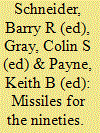

|
|
|
|
|
| Edition |
Westview Replica ed
|
| Publication |
Boulder, Westview Press, 1984.
|
| Description |
xiii, 176p.
|
| Standard Number |
0813370019
|
|
|
|
|
|
|
|
|
|
|
|
Copies: C:1/I:0,R:0,Q:0
Circulation
| Accession# | Call# | Current Location | Status | Policy | Location |
| 025420 | 358.1/SCH 025420 | Main | On Shelf | General | |
|
|
|
|
| 13 |
ID:
164607
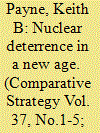

|
|
|
|
|
| Summary/Abstract |
For over two decades since the end of the Cold War, US nuclear policy has been based on a general belief that nuclear deterrence, and thus also nuclear weapons, are of rapidly declining value because international relations had moved toward a much more benign and enduring stage of history. Nuclear weapons supposedly had little or no remaining role to play in US security; the only real questions were how, and how quickly could the United States lead the world to nuclear disarmament. The end of the Cold War, which left the United States as the only standing Superpower inspired this view of history, nuclear deterrence, and nuclear weapons. With the nuclear resurgence of Russia, the rise of China, the mounting nuclear threats from North Korea and potentially Iran, that foundational belief underlying US inattention to its nuclear arsenal is now a manifest fiction, and US nuclear policy must confront, and adjust to a very different reality.
|
|
|
|
|
|
|
|
|
|
|
|
|
|
|
|
| 14 |
ID:
060566


|
|
|
|
|
| Publication |
Boulder, Westview Press, 1982.
|
| Description |
xvii,
|
| Standard Number |
0865319030
|
|
|
|
|
|
|
|
|
|
|
|
Copies: C:1/I:0,R:0,Q:0
Circulation
| Accession# | Call# | Current Location | Status | Policy | Location |
| 021224 | 327.73047/PAY 021224 | Main | On Shelf | General | |
|
|
|
|
| 15 |
ID:
140727
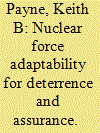

|
|
|
|
|
| Summary/Abstract |
This monograph, Nuclear Force Adaptability for Deterrence and Assurance: A Prudent Alternative to Minimum Deterrence, is the second in a series examining the U.S. goals of deterrence, extended deterrence and the assurance of allies, and how to think about the corresponding U.S. standards of adequacy for measuring “how much is enough?” It begins by examining the manifest character of the contemporary threat environment in which the United States must pursue its strategic goals of deterring foes and assuring allies. Fortunately, there is considerable available evidence regarding the character of the contemporary threat environment and its general directions. Noted historians have compared this threat environment not to the bipolar Cold War, but to the highly dynamic threat environments leading to World War I and World War II. The uncertainties involved are daunting given the great diversity of hostile and potentially hostile states and non-state actors, leaderships, goals, perceptions, and forces that could be involved.
|
|
|
|
|
|
|
|
|
|
|
|
|
|
|
|
| 16 |
ID:
062282
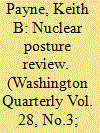

|
|
|
| 17 |
ID:
058907
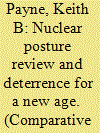

|
|
|
|
|
| Publication |
Oct-Dec 2004.
|
|
|
|
|
|
|
|
|
|
|
|
|
|
|
|
| 18 |
ID:
182005
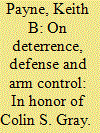

|
|
|
|
|
| Summary/Abstract |
For five decades Professor Colin Gray’s scholarly writings contributed tremendously to our understanding of strategy and his wise counsel benefited U.S. security policies enormously. His intellectual depth, rigor, curiosity and wit were unparalleled, as was the time, energy and stamina he devoted to writing and lecturing. To say that Colin was prolific is a profound understatement. His scholarly published canon includes more than 30 books and 300 articles. He also authored or contributed to scores of unpublished reports for various U.S. government offices. To achieve such a record, Colin often would work on multiple texts simultaneously. As a consequence, two substantial books he authored occasionally would be published in the same year—once I believe in the roughly the same month.
|
|
|
|
|
|
|
|
|
|
|
|
|
|
|
|
| 19 |
ID:
156920


|
|
|
|
|
| Summary/Abstract |
Russian foreign military actions, defense initiatives, markedly expanded conventional and nuclear arms programs, internal repression, and egregious arms control non-compliance are elements of an increasingly assertive and threatening agenda. In this text, we call out and examine the apparent grand strategy underlying Russian policies, programs and behavior.
This examination demonstrates that Russian grand strategy now includes a deeply-troubling mix of ingredients, including increasing hostility toward the West, expanding conventional and nuclear weapons programs, a military doctrine that place much greater emphasis on nuclear weapons and military campaigns against neighboring states.
These developments have created the potential for escalating political military crises in Europe and may be more dangerous than were Soviet Cold War policies and behavior. In particular, contemporary Russian nuclear strategy is intended to coerce the West and enforce Moscow's expansionist moves with nuclear first-use threats and planning that go well beyond Soviet Cold War behavior.
|
|
|
|
|
|
|
|
|
|
|
|
|
|
|
|
| 20 |
ID:
004611
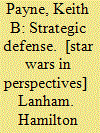

|
|
|
|
|
| Publication |
Lanham, Hamilton Press, 1986.
|
| Description |
xvii, 250p.
|
| Standard Number |
0819151106
|
|
|
|
|
|
|
|
|
|
|
|
Copies: C:1/I:0,R:0,Q:0
Circulation
| Accession# | Call# | Current Location | Status | Policy | Location |
| 035509 | 358.174/PAY 035509 | Main | On Shelf | General | |
|
|
|
|
|
|
|
|
|